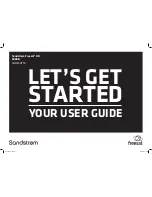
Application Circuit – DC Motor Forward/Reverse Circuit
This is an example of using the RCRC-6R
Receiver for wireless forward and reverse
remote control of a DC motor.
The wiring diagram shows the motor
connected to Relays 1 and 2. Thus it
follows that Buttons 1 and 2 on the
handheld transmitter would control the
motor (e.g. Button 1 for forward, Button 2
for reverse).
With Relays 1 and 2 configured for
Momentary Mode (factory default), the
motor runs in the desired direction only
when the appropriate button on the
transmitter is pressed. When the button is
released, the motor stops.
If the motor is equipped with limit
switches, Relays 1, 2, and 3 could be
configured for Latched Mode. In this
configuration, a momentary press of
Button 1 or 2 would cause the motor to
run continuously in the appropriate
direction, until it reaches the limit switch.
Button 3 can be used to stop the motor at
any time (Relay 3 would not be connected
to anything).
The following pertains to Model KTXW303C6
‐n,
where n=number of channels
FCC ID: QY4KTXW303
“This device complies with Part 15 of the FCC Rules. Operation is subject to the
following two conditions: (1) this device may not cause harmful interference, and (2)
this device must accept any interference received, including interference that may cause
undesired operation.”
INSTRUCTION TO THE USER
Note: This equipment has been tested and found to comply with the limits for a Class B
digital device, pursuant to part 15 of the FCC Rules. These limits are designed to provide
reasonable protection against harmful interference in a residential installation. This
equipment generates, uses and can radiate radio frequency energy and, if not installed
and used in accordance with the instructions, may cause harmful interference to radio
communications. However, there is no guarantee that interference will not occur in a
particular installation. If this equipment does cause harmful interference to radio or
television reception, which can be determined by turning the equipment off and on, the
user is encouraged to try to correct the interference by one or more of the following
measures:
—Connect the equipment into an outlet on a circuit different from that to
which the receiver is connected.
—Consult an experienced radio/TV technician for help.
‐‐‐Reorient or relocate the receiving antenna.
‐‐‐Increase the separation between the equipment and receiver.
Changes or modifications not expressly approved by
Applied Wireless
could void the
user's authority to operate the equipment.


























